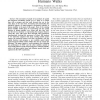Free Online Productivity Tools
i2Speak
i2Symbol
i2OCR
iTex2Img
iWeb2Print
iWeb2Shot
i2Type
iPdf2Split
iPdf2Merge
i2Bopomofo
i2Arabic
i2Style
i2Image
i2PDF
iLatex2Rtf
Sci2ools
MASS
2010
2010
STEP: A spatio-temporal mobility model for humans walks
The movement of people is by-products of spatial and temporal correlations. People go to a place at a certain time with a purpose and they meet because they are in the same place at the same time. Extracting and representing the statistical features of spatio-temporal correlations inherent in human mobility is the goal of this paper. Most of the existing human mobility models focus on representing only the spatial features of human mobility (e.g., where and how they visit) and devote less attention to representing the temporal features (when they visit). This paper shows through GPS experiments simultaneously tracking the movement of about 200 students in two university campuses that many existing models cannot capture the temporal features and their correlations with the spatial features, and proposes a new mobility model called spatio-temporal mobility model (STEP) that aims to remedy this de
| Added | 20 May 2011 |
| Updated | 20 May 2011 |
| Type | Journal |
| Year | 2010 |
| Where | MASS |
| Authors | Seongik Hong, Kyunghan Lee, Injong Rhee |
Comments (0)

